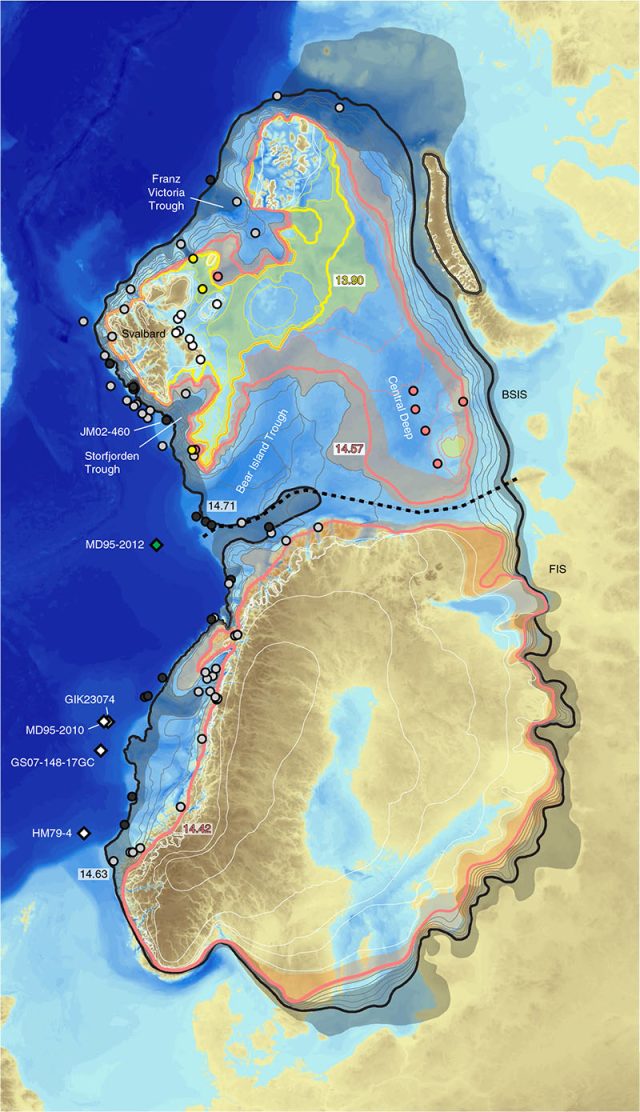The rapid rise of global temperature over the last century is almost certainly unprecedented in recent Earth history, but our current rate of sea level rise has stiffer competition. About 14,650 years ago, as the thawing of the last ice began to hit its stride, sea level made a remarkable jump of 12 meters or more—and did so in less than 400 years. It's an event known to scientists as Meltwater Pulse 1A.
Figuring out where all that water came from hasnt been easy. It was certainly the result of melting glacial ice (and not some sort of biblical sky-flood), but models of past ice sheet change havent quite added up.
A new study led by Jo Brendryen at the University of Bergen takes an interesting route to discover that the melting of the Eurasian Ice Sheet, which has largely been overlooked, might just explain things.
Looking for a date
It actually comes down to carbon dating—measuring the amount of radioactive carbon-14 in something to calculate its age. Carbon dating works a little differently from other types of radiometric dating, in that carbon-14 is constantly produced by reactions in Earths atmosphere. Anything that takes in carbon atoms—which includes living things—will therefore have a similar amount as the atmosphere; once it stops that uptake, carbon-14 will gradually decay and turn into nitrogen-14. The older that thing is, the less carbon-14 will be left in it.
One complication is that the production rate of carbon-14 in the atmosphere varies slightly over time. Because this technique can only be used about 50,000 years or so into the past, however, scientists have been able to use things with known ages (like tree rings) to cross-check and calibrate carbon-14 concentrations to ages.
But in the ocean, theres a second complication. Carbon-14 from the atmosphere gets into surface waters quite easily, but deep water is isolated. That means it could be hundreds of years since the carbon in deep water last saw the atmosphere. If a little baby organism takes in that carbon, its going to look hundreds of years older than it is, in carbon-dating terms.
So just subtract the right number when working with deep ocean samples and its fixed, right? Well, the problem is that the “right number” depends on ocean circulation in that place and at that time. This generally leads to a lot of weeping and gnashing of teeth in paleoceanography.
On ice
Back to the ice sheets. During the last glacial period, an ice sheet once stretched across Scandinavia and the Barents Sea. The record of its shrinking is based on carbon dating of seafloor sediment cores, pinpointing times that ice retreated and life returned to a location. The reconstructions have indicated that the ice here had basically melted before the start of Meltwater Pulse 1A, giving it a clear alibi. But the carbon-dated ages assumed that the deep ocean carbon-14 delay in that region was constant over time, matching the modern pattern.
In this new study, the researchers looked carefully at that assumption. They turned to a seemingly unlikely source—a cave in China. There is actually a pretty good correlation between ocean circulation, the temperatures in the North Atlantic, and the Asian Monsoon rains, linked by a series of climatic dominoes. Cave records have excellent timelines, with annual layers and uranium radiometric dating.
By lining up the wiggles in the cave record and Norwegian Sea sediment records, the researchers avoid having to guess the unknown deep ocean carbon-14 delay. Instead, they can calculate that delay and its changes, providing a new calibration for seafloor paleoclimate records in this region.
With that done, the reconstructed timing of Eurasian Ice Sheet melt shifts. Rather than showing that the local ice melted before Meltwater Pulse 1A even started, they see a major loss of ice during this event. Previous reconstructions gave the Eurasian Ice Sheet credit for perhaps one meter of the 12 or more meters of sea level rise that occurred then. This study pushes that contribution up to about five meters—plus another meter or so in the century following.


arstechnica
[contfnewc] [contfnewc]







